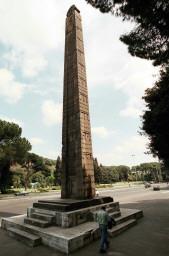A holy monument returned to Ethiopia after years of foot-dragging will be re-erected on the reputed site of the Queen of Sheba's fabled palace in September, Italian officials said Thursday.
The final technical wrinkles are being ironed out and the storied stone will be re-installed at a formal ceremony on September 4, they said.
''It's almost ready,'' they said.
An Italian delegation will attend the ceremony, led by Foreign Undersecretary Alfredo Mantica.
Mantica said the ceremony would ''seal the bond of close friendship between Rome and Addis Abeba while celebrating the high symbolic value of the obelisk, which is much more than a mere artistic monument for the Ethiopians''.
A concrete slipway leading up to the obelisk's site has been completed and the base itself has been reinforced to prevent the monument causing damage to a recently discovered necropolis.
The ceremony has been timed to take place just before the Ethiopian New Year which falls on September 11.
The revered obelisk, looted by Benito Mussolini's Fascist troops, was flown back and re-assembled amid fanfare at the holy city of Axum almost four years ago.
Ethiopians, who consider themselves descendants of the ancient civilisation, clamoured for it to be put up immediately.
But there was a last-minute glitch when the United Nations' cultural body UNESCO - which has nominated Axum a world heritage site - warned its erection might damage the necropolis found under the site.
Work on the obelisk has gone forward since 2005, when the Italian government staged a grand ceremony to restore the huge stone to its rightful owners.
The ancient tomb city stretches for hundreds of square metres and contains invaluable evidence of the ancient kingdom ruled by the Queen of Sheba which dominated the Horn of Africa 2,000 years ago.
When the monument was put back together in situ in April 2005, Ethiopian strongman and premier Meles Zelawi reiterated his country's gratitude to Italy for returning the obelisk after almost 70 years.
Zelawi wrote to then Italian premier Silvio Berlusconi to thank him for his ''courage'' in restoring to Ethiopia a potent symbol of national pride.
He said the gesture would ''significantly improve'' relations between the two countries.
Thousands of Ethiopians gathered to celebrate the return of the third and final section of the 24-metre-high obelisk.
TROUBLED HISTORY.
The 160-tonne obelisk, believed to be some 1,700 years old, was taken from Axum in 1937 by the invading army of Mussolini, eager to make up some ground on the European imperial powers and send home symbols of conquest.
It was originally intended as the centrepiece for EUR, Rome's model Fascist neighbourhood which went up in the late 1930s.
But in the end it was placed in front of the Fascist Ministry for African Colonies, which today houses the United Nation's Food and Agriculture Organization (FAO).
The obelisk became a source of contention between Italy and Ethiopia for decades, with Ethiopian governments demanding its return and accusing Rome of breaking a 1947 pledge to return the monument.
Rome signed two later accords, in 1956 and 1997, to repatriate the treasure.
A final deal was reached in 2003 after Ethiopia threatened to sever diplomatic ties with Rome.
Italian authorities had trouble finding an aircraft able to carry the three massive blocks. In the end, they rented an Antonov, the world's largest civilian cargo plane.
A special runway was built and radar installed for the plane to land safely at Axum 200m above sea level and some 800km north of the Ethiopian capital Addis Ababa.
Italy sent out machinery to put the great stone in place but it was later decided to repackage the sections and wait for the rainy season to end.
As well as being a Coptic (Egyptian Christian) holy place, Axum is a popular tourist venue littered with some 120 stones like the obelisk, some half-standing but most lying on the ground.
Made of dark basalt, the Axum obelisk is actually a funeral stele - a stone tower that was used to mark graves.
Unlike most surviving steles, which are blank, it is decorated with carved designs of windows and doors and topped with a sort of stone crest.
Axum, which dominated the Horn of Africa from the first to the sixth century AD, was reputed one of the four great powers of the time along with Rome, China and Persia, pouring out ivory, animals, textiles, gold, jewels and spices to Roman, Arabian and Indian markets.
It declined as Arab invaders swept in from the north but retained its prestige as the birthpace of Christianity in Ethiopia.
It also enjoys a mythic aura thanks to a legend that Menelik I, son of Solomon and the Queen of Sheba, brought the Ark of the Covenant to Axum from Jerusalem, 1,000 years before Christ.
Some believe the Ark - symbol of God's covenant with the Jews - is still hidden there in a small church built in 1965 by Haile Selassie, last Emperor of Ethiopia and a claimed descendant of Solomon.













